What Hi-Fi? Verdict
The Q9FN is a significant step forward for QLED – one that should make OLED at least a bit nervous
Pros
- +
Astonishingly punchy, bright and vibrant images
- +
Deep, detailed blacks
- +
Loads of apps and features
- +
Genius evolution of OneConnect
- +
Strong handling of motion
Cons
- -
Sony does even better motion
- -
OLED offers even deeper blacks and better viewing angles
Why you can trust What Hi-Fi?
While Samsung’s 2017 QLEDs turned out to be far more than the cynical marketing ploy some suspected, they weren’t the ultimate realisation of quantum dot tech.
In fact, it will probably be a good few years before we get to the point where quantum dots emit their own light in the same way as OLEDs, albeit with better colours and greater brightness.
In the meantime, Samsung is relying on backlights to pass light through the quantum dots of its QLED TVs.
MORE: OLED vs QLED - which is the best TV technology?
Build
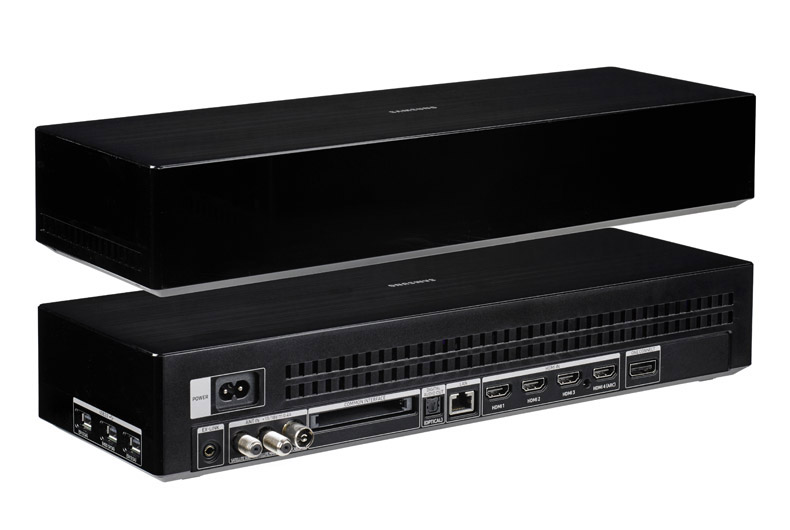
The backlights of last year’s models were all of the edge variety, consisting of LEDs running around the edge of the display and sending light across the back of the panel to the area in need of light.
It’s an effective technology but it does have drawbacks, most notably that the backlight generally raises the brightness of the whole display. In other words, blacks and dark colours tend to lose out when the screen is also displaying a bright element.
The solution (at least until self-emissive quantum dots become viable) is a direct backlight, with a thin sheet of LEDs behind the quantum dots. These LEDs can be lit in zones - the more LEDs a backlight has, and the more zones it can control independently, the greater control it has over the picture quality.
The latest hi-fi, home cinema and tech news, reviews, buying advice and deals, direct to your inbox.
The QE65Q9FN is the first of Samsung’s QLEDs to get a direct LED backlight, and it’s no coincidence it’s also the best QLED yet. It's a genuine threat to the recent dominance of OLED.
MORE: Samsung 2018 TVs – QLED, LCD, 8K, 4K – everything you need to know
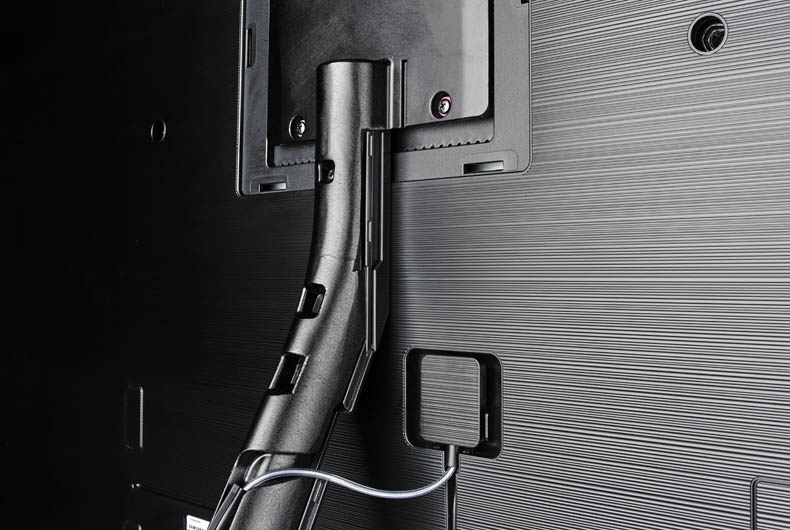
The Q9FN (the N signifies a 2018 model) is available in 55in and 75in sizes as well as the 65in model on review here, and looks smart and sophisticated in its dark grey finish.
Compared with the current crop of OLEDs, it’s rather thick – perhaps as a result of the LED backlight – but Samsung hasn’t tried to disguise the thickness with tapered edges. Instead it's opted for flat sides that exaggerate the set’s bulk.
The OneConnect box supplied with Samsung’s 2018 QLEDs is twice the size of last year’s equivalent, but this bulk has its benefits. The OneConnect not only handles the connections and processing for the TV, it also supplies the power - so the screen needs no direct connection to a wall socket.
Instead there’s just one cable running from it to the OneConnect box, which can itself be hidden away anywhere within the reach of the bundled 5m connecting cable (or optional 15m version).
The cable is a touch thicker than last year’s, but still astonishingly thin considering the data and current it carries. The whole design is neat, particularly when wall-mounted, and there’s a rather elegant pedestal with a channel for running the cable through. It has a small footprint by the standard of 65in TVs, making it comparatively easy to house.
Picture

Getting started is a doddle thanks to Samsung’s first-time set-up, which includes background channel tuning and automatic recognition of your HDMI-connected sources, many of which can be controlled via the TV’s remote.
In fact, the set-up can be streamlined further with the SmartThings app on your phone - this transfers app preferences and logins. Unfortunately the iPhone version of the SmartThings app didn’t work during testing. The Android version is fine, though, and genuinely improves on an already excellent set-up process.
To ensure the Q9FN is performing at its best, we’d recommend a few hours of tweaking and a trusty THX Optimizer disc. First, turn the Eco settings off – they might save a few pennies, but they hamper performance.
You may also want to experiment with the motion processing options too – the Auto mode is too aggressive and unnatural, but the default settings in the Custom mode work rather well.
The resultant motion processing isn’t quite up there with what a well-sorted Sony can do, but it’s a step in the right direction.
MORE: How to set up your TV and get the best picture

For standard dynamic range (SDR) content we’d recommend dropping Contrast setting by about 10 points, Sharpness by five, taking a point off Brightness and upping the Local Dimming to High. This results in the best balance of punch and black depth.
The Q9FN is rated to around 2000 nits, which is about as bright as TVs currently get. It deploys every one of those brightness lice (we may have misunderstood the whole nits thing) in the opening of Guardians of the Galaxy Vol.2. This 4K HDR disc provides a stern test from the beginning, but it’s clear from the first few seconds of the film the Q9FN is a seriously capable set.
We recently praised the Sony KD-65XF9005 for its punch and vibrancy, but the Samsung makes it look flat by comparison. There is a significant price difference between the two sets, it's true, but the extent to which the Q9FN betters the Sony set is rather eye-opening.
Colour is similarly vibrant and vivid on both sets, both major on detail in the brightest and darkest parts of the picture, and both deploy direct LED backlights to maximise punch and brightness. But in all ways but one, the Samsung improves on everything the XF9005 does.
MORE: Guardians of the Galaxy Vol.2 4K Blu-ray review
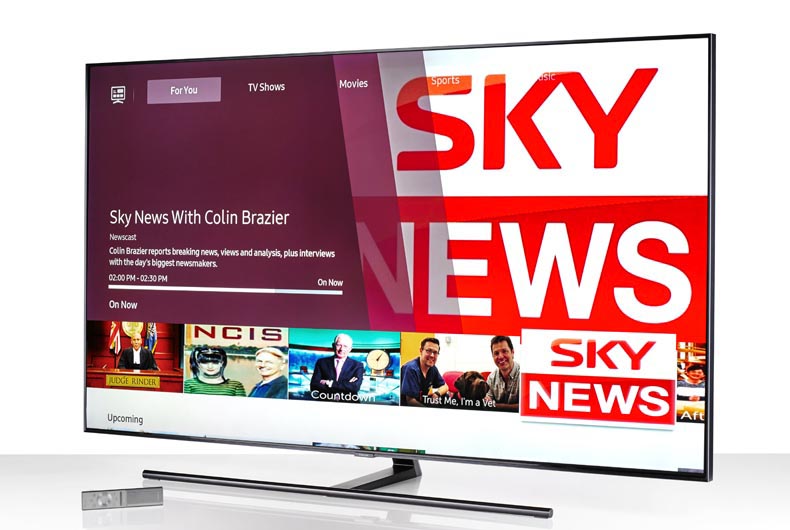
There’s an extra level of vibrancy and lushness in the green fields of 1980s Missouri, and more warmth from the setting sun. The yellow text pops from the screen with significantly greater lusciousness.
And all of this is delivered without forfeiting any realism or naturalness. Tricky elements, such as skin tones, have even greater nuance and subtlety of gradation as every shade is represented and blended to excellent effect.
Pause as the action hovers in space above the Sovereign planets and the Samsung’s peak brightness is astonishing. The golden portions of the globe shimmer and glint against the darkness of space to a degree we’ve not seen before, and the quantity and quality of the stars is exceptional. That there’s no loss of detail in these piercingly bright highlights is further cause for celebration.
In fact, detail across the board is superb. The Samsung reveals the imperfections in the skin of our heroes, makes it possible to count individual hairs or blades of grass, and brings to life every notch and nook of Groot’s ‘skin’.
MORE: What is Ultra HD TV and 4K TV? Everything you need to know

So much of the Q9FN’s success is down to that direct LED backlight. Not only is it capable of producing exceptionally bright highlights, it manages to do so in combination with genuinely deep blacks.
There’s practically no discernible blooming around light objects on otherwise black backgrounds, and no visible rising or lowering of the overall black level when one of the backlight’s zones kicks into action. It’s a quite remarkable achievement, particularly when the distance between the brightest whites and darkest blacks is as great as it is here.
The viewing angles are much improved over last year’s QLED Samsungs. You still lose a little vibrancy and black depth as you move off-axis, but the picture remains pretty consistent at quite obtuse angles.
And where some of Samsung’s more affordable sets, such as the UE65MU7000, deploy deep blacks to highlight edges and exaggerate sharpness, the Q9FN is just naturally sharp. No exaggeration or artificial outlining, just solid, three-dimensional objects and characters.
The one way in which the Q9FN doesn’t humble the XF9005 is motion processing. This will come as no great surprise, as Sony has long been the only TV manufacturer capable of producing motion processing modes that all but eliminate blur and judder without introducing the unrealistic 'soap opera' effect.
MORE: Samsung UE65MU7000 review
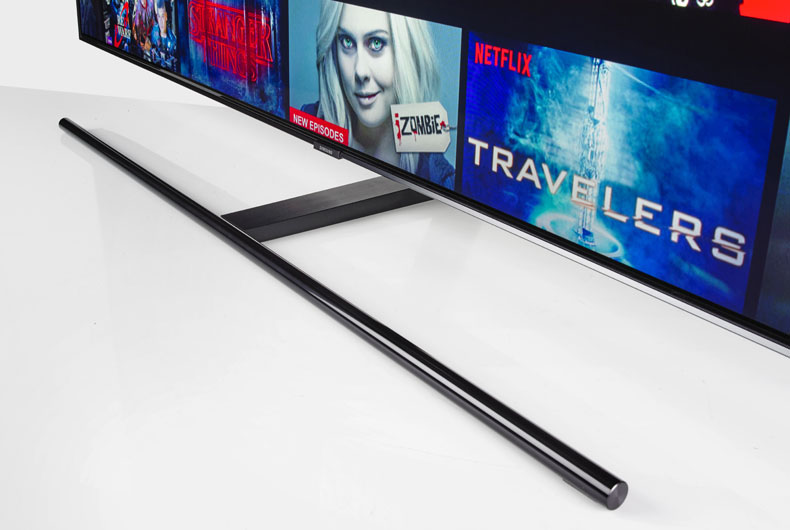
But with the Q9FN, Samsung has closed the gap. For once we’d recommend you don’t turn the set’s motion processing off entirely, and instead opt for the default settings in the Custom mode.
It’s not perfect – there’s a little shimmer to tight patterns as the camera pans, and the set loses its grip a little on the arms that Meredith stretches out of the car at the start of Guardians Of The Galaxy Vol.2 – but this is a marked improvement on Samsung’s 2017 efforts.
The Q9FN more than justifies the extra money it costs over the KD-65XF9005 - but how does it fare against our favourite TV of last year, the Sony KD-65A1, now available for around the same price as this new Samsung? The short answer is ‘extremely well’.
The A1 plays to its OLED strengths in predictable ways, producing even darker blacks that lend a certain deep lusciousness to the picture as a whole, but the Samsung counters with more punch, higher peak brightness and greater detail - particularly in the darkest parts of the picture.
MORE: 4K Ultra HD Blu-ray – all the 4K discs on sale and coming soon
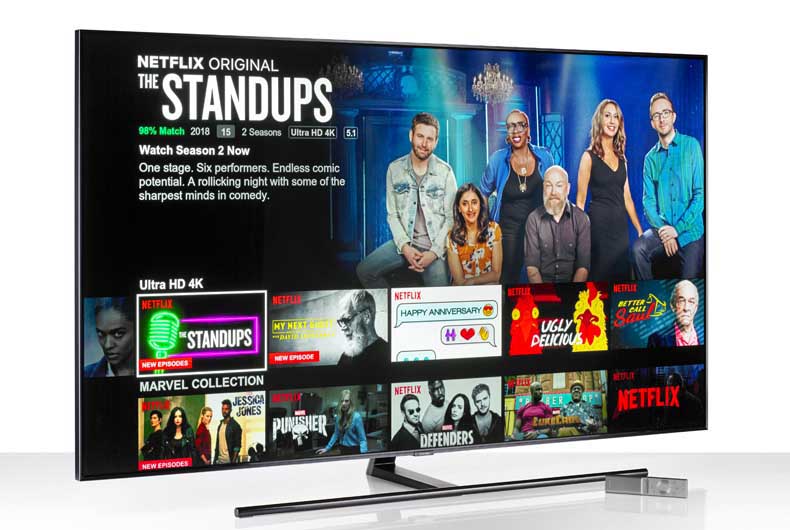
The Q9FN is seriously impressive with standard dynamic range content too. As Joseph Gordon-Levitt’s Joe comes into shot at the start of our Looper Blu-ray, his face is clearly revealed and remarkably detailed in the general gloom of pre-dawn. His skin is natural and nuanced, stubble distinct and controlled, and he’s crisply outlined against the sky and crop of corn behind him.
The scenery shot that follows is dynamic, with the rising sun and resultant lens flare piercing against the otherwise shadowy landscape, and the row of trees in the distance silhouetted dramatically against the brightening sky. Rarely has 1080p looked so good.
Full HD content from the on-board Freeview and satellite tuners is also impressive. It's punchy, sharp and detailed to an extent that few rivals can match. The Q9FN does its very best with standard-def, too. This isn’t up there with the upscaling magic of LG’s 2017 OLEDs but, compared with most rivals, the clarity and lack of noise is impressive.
Samsung should also be applauded for putting some serious consideration into the requirements of gamers. Not only is input lag supremely low (we measure 15.5ms), there are a number of extra features, such as motion smoothing and full support for variable frame rates via the HDMI inputs.
The former adds a little more input lag (but keeps it under 30ms) and the latter currently only benefits PC gamers (the Xbox One X and One S should be getting on board in the next few weeks) - but their presence is a boon to those who take their gaming seriously.
Sound

While Samsung has clearly focused its attention on the Q9FN’s picture quality, sound certainly hasn’t been overlooked.
Choose the Optimised mode and the audio is big, bold and spacious - but with voices that, while not quite as positively projected as they are from some rivals, are clear and distinct, even within the cacophony of an action set-piece.
As sonically capable as the Samsung is, it’s not quite up there with the Sony A1’s intuitive, screen-vibrating solution - and neither telly can match the audio quality of a capable soundbar.
You should budget for one of these at least, although there’s a strong argument that picture quality this good should be partnered by a proper surround-sound system.
MORE: Best soundbar and soundbase deals 2018
Features

Little has changed on the apps front for Samsung since last year, but pretty much every base is covered.
There’s Netflix and Amazon in full 4K HDR form, Now TV for contract-free Sky content, plus Google Play Movies & TV, Rakuten and Samsung’s own (Rakuten-powered) TVPlus app for on-demand streaming of blockbuster films.
The latter is starting to look more worthwhile, thanks to an expansion of its 4K movie library – Blade Runner 2049 is available for rent and purchase at the time of writing, for example.
Apps for all of the UK’s catch-up services are present, too, although BBC iPlayer wouldn’t work during our test. Samsung claims this is a simple licensing issue - but (while we accept this) we will provide an update closer to the TV’s full launch.
MORE: Best video streaming service 2018

Samsung is also pushing the fact its 2018 TVs are part of its SmartThings smart home ecosystem, which includes some of the company’s fridges and robot vacuum cleaners as well as Hue lightbulbs and Ring doorbells.
Having seen the app in action, we’re rather underwhelmed. The functions offered through the TV interface are much more basic than those available via the app on your phone, which is likely to be in your pocket or to hand while you’re watching TV anyway.
The new Ambient mode – clearly a feature of which Samsung is very proud – is more successful, but still of fairly niche appeal. It’s designed for those who find the black, blank screen of a TV on standby aesthetically unsatisfying.
Instead you can display an image or your own photos, with or without live information such as the time, your calendar or a news feed. If the TV is mounted on a patterned wall, you can even replicate the pattern so it blends in.
It’s an interesting idea, and by Samsung’s estimation adds just 68p to your energy bill if used for three hours a day over a whole month. Only time will tell if this proves a popular feature.

While the Q9FN's HDMI inputs aren't officially designated HDMI 2.1, we understand this is more to do with the HDMI 2.1 certification process having not yet begun, rather than an issue with actual spec. After all, the inputs do already include support for HDMI 2.1 features such as variable refresh rate (VRR) for games and eARC (Enhanced Audio Return Channel) for advanced audio formats such as Dolby Atmos.
These may not be hugely useful yet, but could well prove a big deal in the next couple of years when there are more sources available to take advantage.
Meanwhile, the TV's for HDR10+ is no surprise, as it’s a Samsung-developed, dynamic metadata-featuring HDR format to rival Dolby Vision, but it’s of little benefit right now.
Only a handful of shows on Amazon Prime Video currently carry the necessary data, and HDR10+ 4K Blu-rays are not expected until the end of the year.
MORE: HDR10+ – everything you need to know
Verdict
There’s no shortage of reasons to buy the QE65Q9FN – the first being it produces a genuinely stunning picture.
This is the brightest, punchiest, most vibrant TV we’ve reviewed and, thanks to that extremely impressively controlled, zonal backlight, it combines that brightness with genuinely deep but detailed blacks. An OLED will go deeper still but, on the evidence of last year’s models, it won’t go as bright or be as revealing in the darkest areas of the picture.
Add an excellent user interface, capable sound quality, an abundance of apps and thoughtful features to keep gamers happy, and you have a complete package. It’s an extremely close call between this and the Sony KD-65A1 - and while we’ve not yet seen LG’s 2018 OLEDs for testing, this is certainly a contender for one of the best TVs around right now.
The QE65Q9FN is undeniably a huge step on for QLED and a genuine threat to the recent domination of OLED. Not to mention a stunning TV in its own right.
Read all our Samsung reviews
What Hi-Fi?, founded in 1976, is the world's leading independent guide to buying and owning hi-fi and home entertainment products. Our comprehensive tests help you buy the very best for your money, with our advice sections giving you step-by-step information on how to get even more from your music and movies. Everything is tested by our dedicated team of in-house reviewers in our custom-built test rooms in London, Reading and Bath. Our coveted five-star rating and Awards are recognised all over the world as the ultimate seal of approval, so you can buy with absolute confidence.

